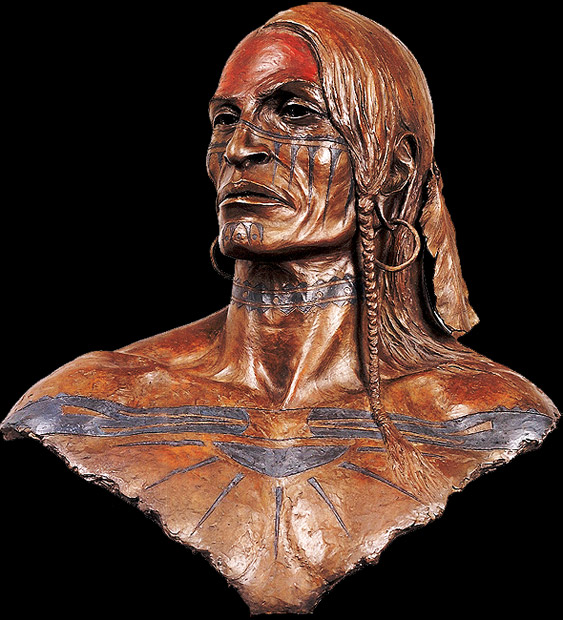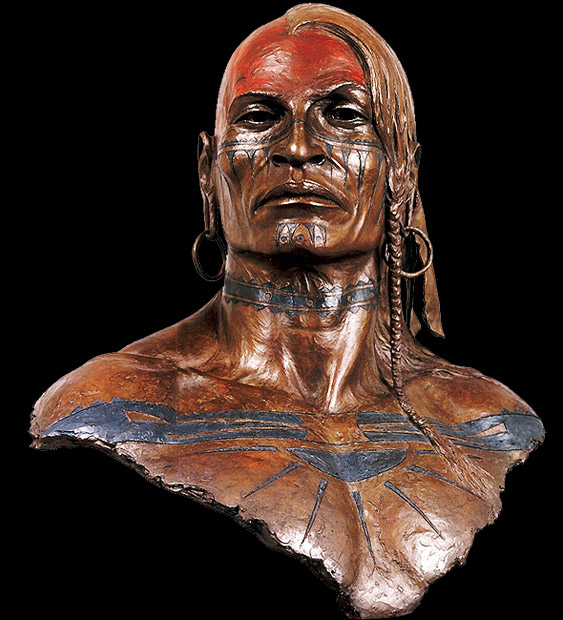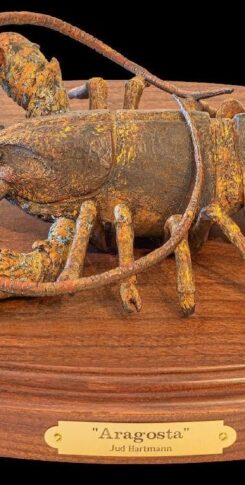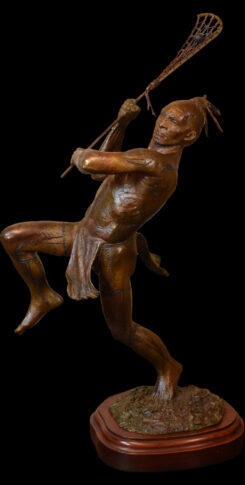Ononkwaya (An Oneida Chief)
Bronze edition: 20 | Height: 24″
“I had always supposed, heretofore, that the paintings and the busts I had seen of the Roman Emperors, represented the ideal of artists rather than men who had actually ever existed… until I came to this country (the land of the Hurons/Iroquois). For among these people, I see everywhere, the heads of Julius Caesar, Augustus, Pompey and others, so strong and so powerful their features!”
Fr. Paul Le Jeune, (1634)
“In 1638, a war party of 100 Iroquois met in the forest a band of 300 Hurons and Algonquin Warriors. They might have retreated and the great number were for doing so; but Ononkwaya, an Oneida chief, refused. ‘Look!’ he said, ‘the sky is clear; the sun beholds us.1 If there were clouds to hide our shame from his sight, we might fly, but as it is, we must fight while we can.’ They stood their ground for a time but were soon overborne. Four or five only escaped but the rest were killed or captured. This year fortune smiled on the Hurons… The prisoners were distributed among the various towns to be burned. These scenes, with them, occured always in the night; and it was held to be the last importance that the torture should be protracted from sunset until dawn.2 The too valiant Ononkwaya was one of the victims. Even in death he took his revenge; for it was thought an augary of disaster to the victors, if no cry of pain could be extorted from the sufferer and on the present occasion, he displayed an unflinching courage, rare even among Indian warriors.3 His execution took place at the town of Teanaustaye, called St. Joseph by the Jesuits.
“On the scaffold where he was burned, he wrought himself into a fury which seemed to render him insensible to pain. Thinking him nearly spent, his tormentors scalped him, then to their amazement, he leaped up, snatched the firebrands that had been instruments of his torture, drove the screeching croud from the scaffold and held them all at bay, while they pelted him from below with sticks, stones and showers of live coals. At length he made a false step and fell to the ground, when they seized him and threw him into the fire. He instantly leaped out, covered with blood and cinders and ashes and rushed upon them with a blazing firebrand in each hand. The crowd gave way before him, and he ran toward the town, as if to set it on fire. They threw a pole across his way, which tripped him and threw him headlong to the earth, on which all fell upon him, cut off his hands and his feet and threw him once again into the fire. He rolled himself out and crawled forward on his elbows and knees glaring upon them with such unutterable ferocity that the crowd recoiled once more, till, seeing that he was helpless, they threw themselves upon him and cut off his head.”
Francis Parkman, 1867, from Fr. Jerome Latemont’s relations 1639.
“None of the most famous heroes of Rome have discovered a greater love of their country or a greater contempt of death than these people.”
“None of the most famous heroes of Rome have discovered a greater love of their country or a greater contempt of death than these people.”
Cadwallader Colden, Lt. Gov. of New York,
“History of the 5 Nations, Iroquois, 1727.
1 The sun is associated with the Iroquois God of war, Areskoui.
2 Captives were killed only after the sun had risen as a sacrifice to Areskoui.
3 Eleven years later, in 1649, the Iroquois utterly destroyed the Huron.
Huron survivors were quick to recall Ononkwaya’s valor as one of
the reasons for their downfall.






